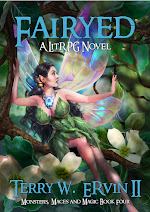Below is my first article I wrote and had published. Over the years it has garnered the most comments and email questions, including another one this past week. That indicates it me it's been helpful to writers.
Dialogue Basics
Dialogue is an essential part of most short stories and novels. It is always better to show or have happen than to explain or to describe. Character conversation, or dialogue, is one way to accomplish this. This article reviews some of the basic structural and punctuation issues of conventional dialogue.
1. Dialogue is set apart or identified with quotation marks. “Words spoken.”
2. Words spoken by a character in a story do not have to be in complete sentences.
3. People in conversations do not always speak in complete sentences or use proper grammar.
4. In a story, make sure your dialogue sounds like what a person would say in conversation.
Make sure all of your characters don’t speak the same. A disgruntled teen skateboarder should not come across the same as a senior citizen on the lamb from a nursing home.
Avoid the use of colons and semicolons within dialogue. (Although some editors do not oppose their use within dialogue)
You should identify who is doing the speaking or make it readily apparent to the reader.
Examples of common dialogue tags include:
I said
She said
Fred said
Mark commented
Sallie yelled
muttered Janice
said Max
asked WilliamIf it is unclear or ambiguous who is speaking it is necessary to add who uttered the words with a dialogue tag before, in the middle of, or after each bit of dialogue.
It is not necessary to explicitly state with a dialogue tag if it is reasonable to expect the reader to know.
“Mom, do I need to eat my liver?”
“Yes, you do. I had to when I was a kid. Ask your grandma.”
“Is that true?” asked Max.
“Did she have to eat this stuff when she was my age?”
"Yes, Little Max. She did, just like you should.”Try to avoid using too many descriptors (yelled, said angrily, cried out, etc.) as the context of the situation and character personality should enable the reader to interpret how something is being said. The word 'said' is almost invisible in dialogue text, while too many descriptors can be distracting.
In a paragraph where a character is identified taking action, it is not necessary to directly identify which character is speaking with a dialogue tag.
Generally speaking, each time a new character speaks it is considered a new paragraph. This assists the reader in following a switch from one character to another in a conversation.
Occasionally, a character's string of dialogue continues from one paragraph to a second. This is identified by not placing the closing quotation mark at the end of the first paragraph and by using an open quote at the beginning of the second paragraph.
Always remember to indent for each new paragraph.
5. Watch punctuation and capitalization with dialogue tags.
Comma after dialogue tag:
John said, “I am happy.”Comma before dialogue tag:
“I am happy,” said John.
If a dialogue tag is in the middle of a character’s statement, the first word after the tag is not capitalized unless the proper noun or personal pronoun requires it:
“Beyond that,” she said, “who knows?”"Even if you get it," she said, "John won't."If end punctuation is an exclamation point or a question mark, the following word in the tag is still not capitalized:
“I am happy!” said John.
Note proper capitalization. If the dialogue tag follows the closed quote of the dialogue, the next word is capitalized if it is a proper noun:
“I am happy,” John said.
When using action to identify the source of dialogue, each sentence stands alone with its punctuation:
John jumped up and down three times. “I am happy!”6. Watch comma use when adding action or information to a dialogue tag:
“I am happy,” said John, jumping up and down.
“I am happy,” said John as he jumped up and down.Below are brief examples showing the various dialogue structures used in combination.
Example 1:
Sally said, “John, don’t eat too much cake!”
Her fiancé dashed to the front door. “You should’ve told me sooner.” He opened it just in time, making a mess on the front porch.
She shook her head and frowned. “I shouldn’t have to tell you such things.”
“Right,” he said and wiped his mouth on his flannel sleeve
“You bet I’m right. And you better clean off my new welcome mat.”
Example 2:
“Oh, no!” cried Sally, “John, I think I’m going to be late!”
“What? Has your watch stopped again?”
Sally shook her wrist before examining the timepiece. “Again!” She tore it off and threw it on the floor. “This is the third time this week.”
"Don’t leave it there. Why don’t you take it back and get a refund?”
“Because, I lost the receipt.”
“You don’t always need one,” said her boyfriend after retrieving the watch from the green shag carpet.
With her left eyebrow arched, she asked, “Are you sure?”
“Yes, I am.” He winked, handing it back to her. “As long as it’s not all broken up.”
The above guidelines and examples should enable beginning writers to successfully incorporate varied and effective dialogue into their short stories and novels. Practice using conventional structures, and an attentive eye while reading established authors, will enable dedicated writers to improve their writing by flexing their dialogue muscle beyond the basics.
© Copyright Terry W. Ervin II. All rights reserved
























